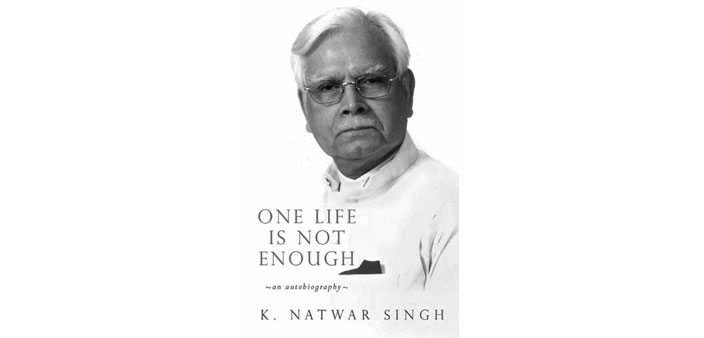Author : K. Natwar Singh
Publisher : Rupa Publishing
Year : 2014
Pages : 464
Price : Rs. 225
K. Natwar Singh, former diplomat and Congress politician was close to the Nehru Gandhi (no relation to Mahatma Gandhi) clan in diplomacy as well as politics. He is the first Rajasthani to be selected to Indian Foreign Service (IFS). As a probationer he had met Jawaharlal Nehru in April 1953; and later, he served Nehru in various positions from the Ministry of External affairs (MEA). He served not only under Nehru but Indira Gandhi as well. He resigned from diplomatic career in 1984, and joined politics under Rajiv Gandhi to serve him, and after him continued to assist his widow, Sonia Gandhi.
But it is under Sonia, that he became a critic of the Congress Party and thus of Sonia herself. In fact, the only person from the Nehru Gandhi clan he gives handsome compliments to, is Sonia’s daughter, Priyanka. He describes her as “attractive and with an engaging personality (and) she shares with her mother’s sartorial elegance”. And, he goes on to add: “Unlike her mother and brother, she is a natural communicator”.
Sonia Gandhi, learning from his interview in Economic Times of 28 April 2014, walked into his home on 6 May 2014, he writes in the preface, with Priyanka, who had sought in advance time to visit him. Sonia had come to find out whether he intended to cover in his book “the events that took place before the swearing-in of the UPA government”. He says, on that day, Priyanka was on a “feminine mufti.” Obviously, he was not going to skip that story!
And the story Sonia Gandhi was so concerned with, and probably keen to prevent it seeing the light of the day, was how and why she decided to make Manmohan Singh the Prime Minister (PM), though earlier she was planning to become the PM herself. Natwar Singh thus claims to know the reasons why “Sonia Gandhi made Manmohan Singh Prime Minister in 2004”. Natwar Singh narrates: “Rahul Gandhi was vehemently opposed to his mother becoming Prime Minister, fearing that she would lose her life, much like his grandmother and his father.”
Turning to foreign policy contents, as a Minister of State under Rajiv, he claims that he was privy to Rajiv’s handling of the Sri Lankan ethnic crisis that flared up a year before Indira Gandhi was assassinated. Rajiv’s agreeing in 1987 to send the Indian Peace Keeping Force (IPKF) to Sri Lanka at the request of the President J. R. Jayewardene, had disastrous effects on Indian foreign policy. Until then India was an honest peace broker between the two warring sides – the Sri Lankan government on one side and and the V. Prabhakaran-led Liberation Tigers of Tamil Eeelam (LTTE). India had core national interests – of security of Tamils in Sri Lanka, at the same time preventing Sri Lanka from seeking the help of any third country like the United States (US) or Pakistan. But Rajiv’s decision, at once made him a partisan, supporting the Sri Lankan government against the LTTE. As a result, the Indian government was neither fully trusted by the Jayewardene government, nor did the Tamils think that the Indian action was in their favour. Sri Lankan Tamils, in reality, felt that IPKF is Innocent People Killing Force!
Natwar Singh was the Minister for External Affairs during the first two years (2004-05) of the UPA I. This review so far has shown that he is not a follower of Sonia Gandhi. But he was also not a fan of Manmohan Singh. Despite the fact that Manmohan Singh, former PM considered India’s Civil Nuclear Deal of July 2005 with the US as his best achievement, Natwar Singh writes that Manmohan Singh “didn’t have” a foreign policy. Foreign policy “was run from Prime Minister’s Office (PMO).” Natwar Singh was Minister for External Affairs from 2004 to 2005. He ought to know it better. Yet, he forgets the fact, whether it is made from PMO or from MEA, it becomes PM’s foreign policy!

